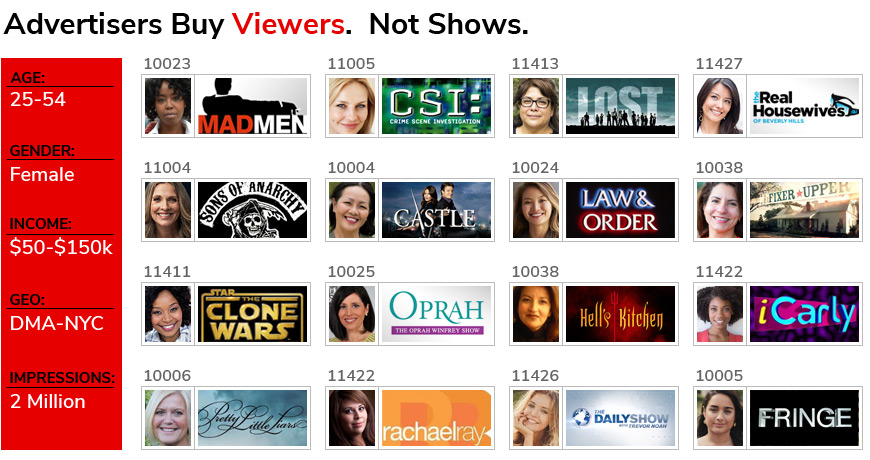The ability of addressable TV to target individual households and their devices across all channels changes the game.
Advertisers buy access to viewers, not shows.
Audience aggregation eliminates the content and timing restrictions of traditional TV advertising by dividing the delivery process into two steps:
- Network spots are designated to receive addressable advertising
- The specific advertisement displayed is personalized for each device
This simple shift has far-reaching implications:
|
The right audiences are reached, no matter what, when or how they’re watching |
Advertisers only pay for their desired audience at a reduced overall cost | Commercial breaks can produce more aggregate ad revenue per unit of time |
| Ad inventory value increases, especially long-tail inventory (programs with small audiences) | Scheduling lead times can be reduced to drive more efficient allocation |
Advertisers place one media buy while targeting specific audiences with different ad messaging |
| Traditional linear TV | INVIDI addressable system |
|---|---|
| Advertiser purchases a spot to be aired during a specific program, often well in advance. Ads are delivered to the entire program audience regardless of relevance, resulting in: |
Advertiser purchases access to an audience and the system delivers the message whenever and whatever they’re watching. Ads are delivered to their highest value target, resulting in: |
|
|
The only ways to increase ad revenue:
|
EVERYBODY WINS |
Desired impressions no matter when the target is watching
The INVIDI system works to meet the desired impressions by playing ads that match the pre-selected targeting criteria. With Aggregation, an impression at 2 a.m. is just as relevant as an impression at 8 p.m. because the ad plays on a set-top box that matches the household demographic information the advertiser desires when the target audience is believed to be watching.

For example, assume a cruise line has a family cruise campaign and wants to target households with an income over $100K, kids under age 17, and a history of travel (based on buying patterns or history). With Aggregation, the family cruise ad might play when a mom is watching cartoons with her kids, when a dad is watching late-night television, or when both parents are enjoying their favorite crime drama rerun in the evening. Because the INVIDI system knows to play this ad only on set-top boxes identified with a household income greater than $100K, kids age 2-17, and a preference for travel, the advertiser reaches the desired demographic, without regard to when or what channel viewers are watching.
Learn more about audience aggregation
Interested in knowing more about the audience aggregation capabilities of the INVIDI system? Contact us and we’ll answer your questions one-on-one
